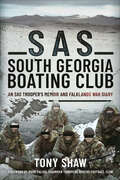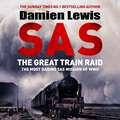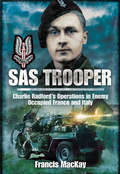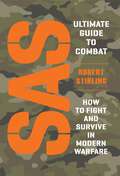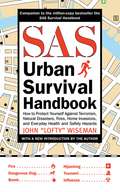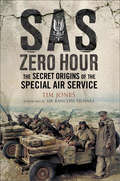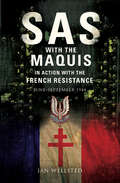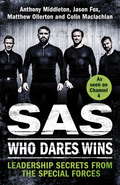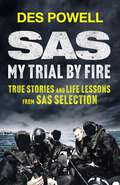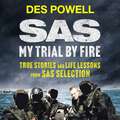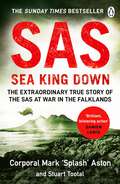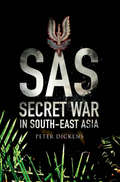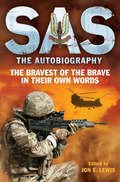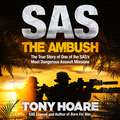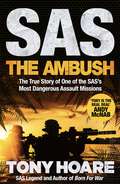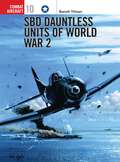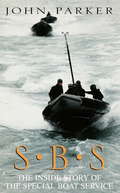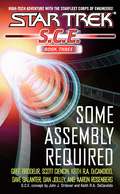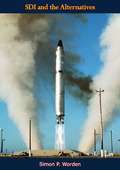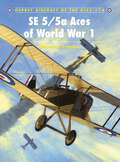- Table View
- List View
SAS South Georgia Boating Club: An SAS Trooper's Memoir and Falklands War Diary
by Tony ShawMany aspire to serve with the Special Air Service, arguably the world’s most prestigious regiment, but few achieve their aim. In this inspiring memoir the author describes how he left school without any qualifications and embarked on a 30 year career much of it spent in Hereford, including four years in ‘The Regiment’. Against the odds he rose through the ranks before being commissioned and eventually retiring as a Major. Initially attached to 22 SAS as a signaller, he volunteered for and passed ‘Selection’, the most gruelling and demanding of tests. He was posted to D Squadron Boat Troop with whom he saw active service in the Falklands War, Northern Ireland and the UK counter-terrorist team. Thanks to the diary he kept during the Falklands War, the reader is treated to a gripping first-hand account of the intense action that he and his colleagues experienced, including recces, diversionary attacks, raids and ambushes both on South Georgia and the Falklands Islands. Later he commanded the Royal Signals troop supporting D Squadron, 22 SAS before commissioning and later on pursuing a second career as a security consultant in various Middle Eastern hotspots. It is a privilege to read this commendably modest account of one man’s unique career which provides a fascinating insight into elite special forces soldiering.
SAS The Great Train Raid: The Most Daring SAS Mission of WWII
by Damien LewisSo secret was this mission, the SAS seizure of a train to raid deep into enemy territory to liberate a concentration camp, that it wasn't until 1968 - twenty-seven years after the formation of the SAS - that a short mention of it was made in the Rover and Wizard annual, under the headline 'Who Dares Wins'. No further published record exists. Best-selling author Damien Lewis has unearthed the full incredible story from long-hidden files and first hand-testimony, his latest elite forces narrative delivering a scintillating tale of bravery, daring and determination which simply beggars belief. This is the SAS at their very finest; there is no other mission like it from the Second World War.
SAS Trooper: Charlie Radford's Operations in Enemy-Occupied France and Italy
by Francis MackayA prewar Sapper, Charlie Radford served in North Africa until he returned to the UK for parachute training. He volunteered and joined 2 SAS in Scotland. His first operation was in France (Op RUPERT) cutting railway lines, and he then took park in Operation LOYTON, now in armed jeeps. His next assignment (Operation ZOMBIE) involved parachuting into the Italian Dolomites to disrupt the vital German link north of Verona between Italy and Austria.This operation ended in failure due to foolhardy leadership, inadequate manning and poor preparation. His OC was captured, tortured and executed but Charlie escaped to live with the partisans before being repatriated to the UK. After the war he returned to France to help with the exhumation and reburial of SAS men executed in the Vosges mountains. Postwar he served in Kenya and Somaliland and briefly recounts his experiences.
SAS Ultimate Guide to Combat
by Robert Stirling'I'm not going to teach you how to survive in snowy mountains with only a tea bag; this book will teach you how to fight and survive war in the 21st century.'--Robert Stirling, from the IntroductionIn the tradition of John 'Lofty' Wiseman's SAS Survival Handbook comes a new combat handbook from a seasoned speical forces soldier. Whereas Wiseman initiated hundreds of thousands of readers to the survival techniques developed by the SAS in far-flung covert ops in Burma, the Middle East, Africa, and elsewhere, Stirling's focus is on fighting techniques for the contemporary soldier.Stirling, a combat veteran of Northern Ireland, the Bush Wars in Africa, and Afghanistan, provides a fully-illustrated training-manual for combat readiness. This is the stuff they don't teach you in boot camp, but they damn well should. Stirling writes in a aggressive style that will appeal to the warrior in every reader. He also serves up first-hand anecdotes and advice drawn from operations that went well--and those that went wrong. Table of Contents: Why Do You Need This Book - Tools of the Soldier's Trade - Food, Shelter & Dealing with Weather - Medical Aid - How to Avoid Getting Shot - How to Avoid Blast Injury - How to Deal with Suicide Bombers - How to Deal with Bombs Under the Road - How to Survive an Interrogation - Defending a Position - Attacking the EnemyE-book information forthcoming
SAS Urban Survival Handbook: How to Protect Yourself Against Terrorism, Natural Disasters, Fires, Home Invasions, and Everyday Health and Safety Hazards
by John Lofty" WisemanJohn "Lofty" Wiseman is the author of the bestselling SAS Survival Handbook, the definitive guide to survival in the wild from Britain's Special Air Service. Now he has compiled a complete guide to survival in the urban jungle. Every year in America there are thousands of fatal accidents in the home—more than on the roads, and many more than in the great outdoors. Fire, electricity, water, gas, sharp knives, poisons, chemicals—these valuable tools can quickly become dangerous weapons when not treated with proper respect and understanding. Add to these the risks of travel, terrorism, muggings, rape, tsunamis, and earthquakes. We are constantly reminded that the world is a dangerous place. Wiseman shows readers how to think realistically and practically about these perils in order to avoid them, whether they are at home, on the street, in school, or in transit. From self-defense techniques to home security systems to coping with natural disasters, this book will teach readers to recognize risks, make quick decisions, and live confidently in the modern urban world.
SAS Zero Hour: The Secret Origins of the Special Air Service
by Tim JonesThe historian and author of Postwar Counterinsurgency and the SAS reveals the full story of how the Special Air Service Regiment began during WWII. Britain&’s elite Special Air Service Regiment is one of the most revered special-ops units in the world. Its high-profile operations include the storming of the Iranian Embassy in London in 1980 and the hunt for Osama bin Laden in southern Afghanistan following 9/11. Since its inception during the Second World War, the SAS has become a byword for the highest possible standards in both conventional and unorthodox methods of warfare. In SAS Zero Hour, military historian and SAS expert Tim Jones offers fascinating new insight into how this elite regiment began. It is commonly held that the unit was the brainchild of just one man, David Stirling. While not dismissing Stirling&’s considerable contribution, Jones&’s historical investigation reveals many other factors that played a part in shaping the SAS, including the roles of military deception specialist Dudley Clarke, Field Marshals Archibald Wavell and Claude Auchinleck, and others. Drawing extensively on primary sources, as well as reassessing the more recent regimental histories and memoirs, SAS Zero Hour is &“The most comprehensive and enlightening version of these seminal events yet&” (Sir Ranulph Fiennes, from the Forward).
SAS with the Maquis: In Action with the French Resistance, June–September 1944
by Ian WellstedOn the night of 5/6 June 1944, D-Day, a Lockheed Hudson dropped a small group of parachutists into the mountainous Morvan area of central France. Their mission was to operate as an advance reconnaissance party 400 miles behind the German lines and to make contact with the French Resistance.One of the team, later to become its commander, was Ian Wellsted, known by his nom-de-guerrre of Gremlin. During the next three months No.1 Troop of the 1st Special Air Service Regiment relayed vital information about enemy troop locations and movements, sabotaged bridges and supply lines, skirmished with German columns and harried the occupying forces as they retreated eastwards in the face of the Allied invasion.Camped deep in the woods of the Montsaughe region, the small force worked alongside the local groups of Maquis, forging strong links of mutual respect and friendship.Ian Wellsteds exciting first-hand account of his operations behind enemy lines is a tale of gallantry and daring, of comradeship and cooperation, full of humour and perceptive insight revealing one of the most significant chapters in the history of the SAS.
SAS: Leadership Secrets from the Special Forces
by Jason Fox Anthony Middleton Matthew Ollerton Colin MaclachlanLife and leadership lessons from the Special Forces, from the stars of Channel 4 series SAS: Who Dares Wins - including Sunday Times bestselling author of FIRST MAN: LEADING FROM THE FRONT, Ant MiddletonAre you up to the challenge of SAS leadership? Only the best will succeed... Britain's SAS (Special Air Service) has an unparalleled reputation for soldiering excellence. Their skills and techniques have been perfected in the most demanding environments imaginable, but many of these can also be used in our everyday lives. This book takes situations all of us will experience during our lives and presents tactical lessons drawn from SAS training and battlefield experience. Its four authors - stars of the hit Channel 4 show SAS: Who Dares Wins - how their finely honed understanding of how to handle extreme challenges can be applied in any environment. Their advice on negotiation, people management, self-motivation and resilience, among other things, can transform your performance in a whole range of scenarios: from buying a house, nailing a job interview, and the experience of dealing with rejection, to maintaining a diet, or managing that pushy colleague at work.This is the ultimate guide to leadership and personal achievement.
SAS: My Trial By Fire: True Stories and Life Lessons from SAS Selection
by Des PowellDes Powell left school with no qualifications and little in the way of formal education. At nineteen he signed up to join the Parachute Regiment.Famously, the Paras is home to the UK military's second-toughest training regime after the SAS. Des Powell knows all about both. In fact, Des knows SAS selection better than anyone because he's done it twice. In SAS: Trial by Fire he tells the story of those gruelling tests: how Para training turned him into a soldier but, more crucially, how the SAS process turned him into a member of the elite.Des describes exactly what it takes to be an elite special forces operator. From raw recruit to trained fighting machine - including the heart-breaking moment he was forced to withdraw, only to begin the process again - Des shares the details of his personal journey, itself a tale of prevailing against almost overwhelming odd. He teaches us valuable life skills by taking us deep into the training regime itself: fitness, navigation, endurance, weapons and combat training, survival techniques in hostile climates, the terrifying jungle phase, the dark arts of escape and evasion, the secret of surviving interrogation.No one's lifted the lid on what it takes to join the SAS and become the best of the best. Until now.Praise for Bravo Three Zero'A must read. Honesty, integrity and real experience that puts you in the thick of the action.' Billy Billingham'The story that needed to be told' Jason Fox'The attention to detail is unbelievable' Tim Lovejoy'Thrilling' Express
SAS: My Trial By Fire: True Stories and Life Lessons from SAS Selection
by Des PowellDes Powell left school with no qualifications and little in the way of formal education. At nineteen he signed up to join the Parachute Regiment.Famously, the Paras is home to the UK military's second-toughest training regime after the SAS. Des Powell knows all about both. In fact, Des knows SAS selection better than anyone because he's done it twice. In SAS: Trial by Fire he tells the story of those gruelling tests: how Para training turned him into a soldier but, more crucially, how the SAS process turned him into a member of the elite.Des describes exactly what it takes to be an elite special forces operator. From raw recruit to trained fighting machine - including the heart-breaking moment he was forced to withdraw, only to begin the process again - Des shares the details of his personal journey, itself a tale of prevailing against almost overwhelming odd. He teaches us valuable life skills by taking us deep into the training regime itself: fitness, navigation, endurance, weapons and combat training, survival techniques in hostile climates, the terrifying jungle phase, the dark arts of escape and evasion, the secret of surviving interrogation.No one's lifted the lid on what it takes to join the SAS and become the best of the best. Until now.Praise for Bravo Three Zero'A must read. Honesty, integrity and real experience that puts you in the thick of the action.' Billy Billingham'The story that needed to be told' Jason Fox'The attention to detail is unbelievable' Tim Lovejoy'Thrilling' Express
SAS: Sea King Down
by Stuart Tootal Mark AstonThe thrilling, edge-of-your-seat true story of one soldier's Special Forces operations in the Falklands War'BRILLIANT. A ROLLERCOASTER OF BLISTERING ACTION, SURVIVAL AND BEHIND-THE-LINES DARING' DAMIEN LEWIS________THE BIGGEST SINGLE LOSS OF LIFE FOR THE SAS SINCE WORLD WAR TWO . . .1982, the British task force sails to liberate the Falkland Islands. Aboard: SAS D Squadron, determined to make their mark.No one more so than Mark 'Splash' Aston.But they have barely seen action when their Sea King helicopter crashes in freezing South Atlantic waters, killing 22 of Mark's comrades.The last out of the sinking wreck, he suffers a broken neck. But defying medical evacuation orders, Mark sneaks off ship, re-joins his SAS comrades to land on a mountain near Port Stanley - to defend it against days of attacks by Argentine special forces . . .SAS Sea King Down is a pulse-pounding account of D-Squadron's tragic loss and subsequent heroic stand in one of the most hostile places on Earth.A story told by a man who barely survived to tell it.________'A gripping untold story of heroism, hardship and sacrifice within the SAS' BEAR GRYLLS 'Gripping, fast moving and completely authentic. A brilliant piece of work. Better than Bravo Two Zero' - Mike Rose, former Commanding Officer of the SAS
SAS: Secret War In South-east Asia (Greenhill Military Paperback Ser.)
by Peter DickensFrom 1963 to 1966 Britain successfully waged a secret war to keep the Federation of Malaysia free from domination by Soekarno's Indonesia and by Chinese Communists. At the forefront of this campaign were the men of the Special Air Service the SAS an elite branch of the British military whose essence is secrecy and whose tools are boldness, initiative, surprise, and high skill.Working in four-man patrols, the SAS teams first made friends with the head-hunting border tribes and even trained some of them as an irregular military force. As the conflict continued, SAS teams went beyond the borders into Indonesia, where they tracked down enemy camps, fired on supply convoys, staged ambushes, and attacked enemy soldiers in their riverboats.By talking to those who were there, Peter Dickens has recreated what it was really like to fight in the jungles of Malaysia. He also captures the bravery and relentless pursuit of excellence that make the SAS the elite and prestigious regiment it is.
SAS: The Autobiography
by Jon E. LewisSAS: The Autobiography is the story of the world's most famous special forces regiment by those who truly know it - the troopers and officers themselves. From the dust of the wartime desert and raids on harboured Luftwaffe aircraft to sniping al-Qaeda in the far mountains of Afghanistan, SAS: The Autobiography takes the reader on a high adrenaline history of the regiment which simultaneously lifts the shroud of mystery from the regiment's operations.Reviews for Jon E Lewis's The English Soldier: An Autobiography: 'A triumph' - Saul David, author of Victoria's Army'Harrowing, funny and often unbelievable book.' - Daily Express'[A] compelling tommy's eye view of war from Agincourt to Iraq' - Daily Telegraph
SAS: The Autobiography (Brief Histories )
by Jon E. LewisSAS: The Autobiography is the story of the world's most famous special forces regiment by those who truly know it - the troopers and officers themselves. From the dust of the wartime desert and raids on harboured Luftwaffe aircraft to sniping al-Qaeda in the far mountains of Afghanistan, SAS: The Autobiography takes the reader on a high adrenaline history of the regiment which simultaneously lifts the shroud of mystery from the regiment's operations.Reviews for Jon E Lewis's The English Soldier: An Autobiography: 'A triumph' - Saul David, author of Victoria's Army'Harrowing, funny and often unbelievable book.' - Daily Express'[A] compelling tommy's eye view of war from Agincourt to Iraq' - Daily Telegraph
SAS: The True Story of One of the SAS's Most Dangerous Assault Missions
by Tony Hoare'Tony is the real deal.' Andy McNabSierra Leone, 2000.While on patrol as part of a peacekeeping mission, eleven British soldiers are kidnapped.The captors are a dangerous rebel group known as the West Side Boys. Fuelled by alcohol and drugs, the behaviour of the rebels is notoriously unpredictable. How long the soldiers have, no one knows. Rescuing them becomes the British military's highest priority, and so they bring in the SAS for Operation Barras, a mission that will go down in special forces history.After negotiations break down, there are fears that the men being held in the compound could be executed at any moment, but there is no easy way in to save them. The only option is to shock the enemy on their home turf. A plan is put in place. The ambush begins.Told from the perspectives of multiple people involved in the operation, and with Tony Hoare's expert insight into the forces, this is a heart-pounding retelling of one of the SAS's most dangerous missions.
SAS: The True Story of One of the SAS's Most Dangerous Assault Missions
by Tony Hoare'Tony is the real deal.' Andy McNabSierra Leone, 2000.While on patrol as part of a peacekeeping mission, eleven British soldiers are kidnapped.The captors are a dangerous rebel group known as the West Side Boys. Fuelled by alcohol and drugs, the behaviour of the rebels is notoriously unpredictable. How long the soldiers have, no one knows. Rescuing them becomes the British military's highest priority, and so they bring in the SAS for Operation Barras, a mission that will go down in special forces history.After negotiations break down, there are fears that the men being held in the compound could be executed at any moment, but there is no easy way in to save them. The only option is to shock the enemy on their home turf. A plan is put in place. The ambush begins.Told from the perspectives of multiple people involved in the operation, and with Tony Hoare's expert insight into the forces, this is a heart-pounding retelling of one of the SAS's most dangerous missions.
SAS: The True Story of One of the SAS's Most Dangerous Assault Missions
by Tony Hoare'Tony is the real deal.' Andy McNabSierra Leone, 2000.While on patrol as part of a peacekeeping mission, eleven British soldiers are kidnapped.The captors are a dangerous rebel group known as the West Side Boys. Fuelled by alcohol and drugs, the behaviour of the rebels is notoriously unpredictable. How long the soldiers have, no one knows. Rescuing them becomes the British military's highest priority, and so they bring in the SAS for Operation Barras, a mission that will go down in special forces history.After negotiations break down, there are fears that the men being held in the compound could be executed at any moment, but there is no easy way in to save them. The only option is to shock the enemy on their home turf. A plan is put in place. The ambush begins.Told from the perspectives of multiple people involved in the operation, and with Tony Hoare's expert insight into the forces, this is a heart-pounding retelling of one of the SAS's most dangerous missions.
SBD Dauntless Units of World War 2
by Barrett Tillman Tom TullisUnquestionably the most successful dive-bomber ever to see frontline service with any air arm, the Douglas SBD Dauntless was the scourge of the Japanese Imperial Fleet in the crucial years of the Pacific War of World War II (1939-1945). The revolutionary all-metal stressed-skin design of the SBD exhibited airframe strength that made it an ideal dive-bomber, its broad wing, with horizontal centre section and sharply tapered outer panels with dihedral, boasting perforated split flaps that doubled as dive brakes during the steep bombing attacks
SBIR at the Department of Defense
by Technology Committee on Capitalizing on Science Innovation An Assessment Of The Small Busin Program—Phase IICreated in 1982 through the Small Business Innovation Development Act, the Small Business Innovation Research (SBIR) program remains the nation's single largest innovation program for small business. The SBIR program offers competitive awards to support the development and commercialization of innovative technologies by small private-sector businesses. At the same time, the program provides government agencies with technical and scientific solutions that address their different missions. "SBIR at the Department of Defense" considers ways that the Department of Defense SBIR program could work better in addressing the congressional objectives for the SBIR program to stimulate technological innovation, use small businesses to meet federal research and development (R & D) needs, foster and encourage the participation of socially and economically disadvantaged small businesses, and increase the private sector commercialization of innovations derived from federal R&D. An earlier report, "An Assessment of the Small Business Innovation Research Program at the Department of Defense," studied how the SBIR program has stimulated technological innovation and used small businesses to meet federal research and development needs. This report builds on the previous one, with a revised survey of SBIR companies. "SBIR at the Department of Defense" revisits some case studies from the 2009 study and develops new ones, and interviews agency managers and other stakeholders to provide a second snapshot of the program's progress toward achieving its legislative goals.
SBS
by John ParkerThe men of the SBS are the maritime equivalent of their counterparts in the SAS; they are the elite of the British Special Forces and also the most secretive. Although SAS activity has been extensively documented, the SBS has remained in the state it prefers - a shadowy silhouette, with identities protected and missions kept from public view. Formed during the Second World War, when they took part in many daring raids (one of which was filmed as The Cockleshell Heroes), they were active in the jungle campaigns in the Far East, in the Falklands, the Gulf War and Bosnia. Since this seminal book was published in 1997, John Parker has been privy to much more inside information about the SBS's original operations and he brings the book right up to date with accounts of their exploits in East Timor, Somalia, Sierra Leone, Kosovo and most recently in Iraq.
SBS
by John ParkerThe men of the SBS are the maritime equivalent of their counterparts in the SAS; they are the elite of the British Special Forces and also the most secretive. Although SAS activity has been extensively documented, the SBS has remained in the state it prefers - a shadowy silhouette, with identities protected and missions kept from public view. Formed during the Second World War, when they took part in many daring raids (one of which was filmed as The Cockleshell Heroes), they were active in the jungle campaigns in the Far East, in the Falklands, the Gulf War and Bosnia. Since this seminal book was published in 1997, John Parker has been privy to much more inside information about the SBS's original operations and he brings the book right up to date with accounts of their exploits in East Timor, Somalia, Sierra Leone, Kosovo and most recently in Iraq.
SCE Omnibus Book 3: Some Assembly Required
by Scott Ciencin Dave Galanter Greg Brodeur Dan Jolley Aaron RosenbergNeed to corral a group of giant monsters that fell through an interdimensional gateway? Need to get your brand-new planetary computer system working -- but the instructions are written in an alien language? Contact the Starfleet Corps of Engineers team on the U.S.S. da Vinci. Led by Captain David Gold and former Starship Enterprise engineer Commander Sonya Gomez, the crew live by their motto: Have tech, will travel. Overseen by Starfleet legend Captain Montgomery Scott, the S.C.E. crew must solve the mystery of an outpost attacked by a strange new weapon and improvise a way to defeat a foe who has them outgunned in a heart-stopping space battle. Join Starfleet's miracle workers for a death-defying journey! SCE OMNIBUS BOOK 3: SOME ASSEMBLY REQUIRED contains the complete eBook editions of S.C.E. adventures #9-12.
SCE Omnibus Book 3: Some Assembly Required
by Scott Ciencin Dave Galanter Greg Brodeur Dan Jolley Aaron RosenbergNeed to corral a group of giant monsters that fell through an interdimensional gateway? Need to get your brand-new planetary computer system working -- but the instructions are written in an alien language? Contact the Starfleet Corps of Engineers team on the U.S.S. da Vinci. Led by Captain David Gold and former Starship Enterprise engineer Commander Sonya Gomez, the crew live by their motto: Have tech, will travel. Overseen by Starfleet legend Captain Montgomery Scott, the S.C.E. crew must solve the mystery of an outpost attacked by a strange new weapon and improvise a way to defeat a foe who has them outgunned in a heart-stopping space battle. Join Starfleet's miracle workers for a death-defying journey! SCE OMNIBUS BOOK 3: SOME ASSEMBLY REQUIRED contains the complete eBook editions of S.C.E. adventures #9-12.
SDI and the Alternatives
by Simon P. WordenThe controversial, sometimes emotional national debate over strategic defense has been overshadowed recently by other, even weightier national and global issues. Research programs for the Strategic Defense Initiative continue, however, and the debate is likely to resume as visible results of that research begin to compete for a share of the nation’s budget. It is in the national interest that this debate proceed in an atmosphere of rational, objective analysis.This study—by an experienced scientist and military expert—provides a basis for such analysis. Colonel Simon P. Worden, US Air Force, considers strategic defense in the context of four competing strategic theories: (1) deterrence through mutual assured destruction, (2) deterrence through nuclear warfighting, (3) deterrence relying on non-nuclear defense, and (4) disarmament. He points out misconceptions and exaggerations of earlier SDI debate, taking to task those in the scientific community who abandoned objective analysis to pursue a political agenda. His fundamental theme is that non-nuclear, space-based defense is not only feasible, but in some ways preferable to reliance on weapons of mass destruction. To support his case, he outlines the phases of a proposed actual system.As Worden notes, the ultimate decisions on strategic defense are up to the American people and their representatives. Such decisions will no doubt take in a range of factors—economic, political, technical, and ethical—as all important national decisions should. Worden offers a reasoned case for strategic defense as an alternative strategy for deterring war.
SE 5/5a Aces of World War I
by Norman Franks Harry DempseyThe SE 5/5a British single-seat aircraft was one of the major fighting scouts of the last 18 months of the war in France during World War I and was a true workhorse of the Royal Flying Corps, handling fighter-versus-fighter actions, combating the high-flying German photo-reconnaissance planes as well as balloons. A total of five SE 5/5a pilots, including the legendary Albert Ball, received the Victoria Cross, Britain's highest award for gallantry. A detailed account of the SE 5/5a, this title covers the development of the machine and its first tentative initiation into combat on the Western Front until it grew in stature to become a machine feared by the German Air Service. Packed with first-hand accounts and combat reports, this is a thrilling insight into the dangerous dogfights and fearless actions of the pilots who flew the SE 5/5a, bringing to life the deadly exploits of these "knights of the air" as they dueled for dominance over the Western Front.
